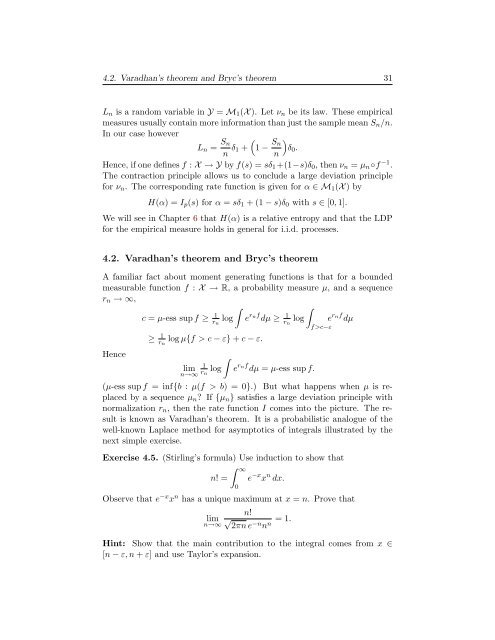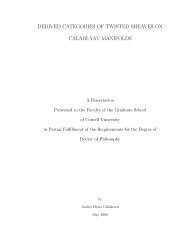A Course on Large Deviations with an Introduction to Gibbs Measures.
A Course on Large Deviations with an Introduction to Gibbs Measures.
A Course on Large Deviations with an Introduction to Gibbs Measures.
You also want an ePaper? Increase the reach of your titles
YUMPU automatically turns print PDFs into web optimized ePapers that Google loves.
4.2. Varadh<strong>an</strong>’s theorem <strong>an</strong>d Bryc’s theorem 31<br />
Ln is a r<strong>an</strong>dom variable in Y = M1(X ). Let νn be its law. These empirical<br />
measures usually c<strong>on</strong>tain more informati<strong>on</strong> th<strong>an</strong> just the sample me<strong>an</strong> Sn/n.<br />
In our case however<br />
Ln = Sn<br />
n δ1<br />
<br />
+ 1 − Sn<br />
<br />
δ0.<br />
n<br />
Hence, if <strong>on</strong>e defines f : X → Y by f(s) = sδ1+(1−s)δ0, then νn = µn◦f −1 .<br />
The c<strong>on</strong>tracti<strong>on</strong> principle allows us <strong>to</strong> c<strong>on</strong>clude a large deviati<strong>on</strong> principle<br />
for νn. The corresp<strong>on</strong>ding rate functi<strong>on</strong> is given for α ∈ M1(X ) by<br />
H(α) = Ip(s) for α = sδ1 + (1 − s)δ0 <strong>with</strong> s ∈ [0, 1].<br />
We will see in Chapter 6 that H(α) is a relative entropy <strong>an</strong>d that the LDP<br />
for the empirical measure holds in general for i.i.d. processes.<br />
4.2. Varadh<strong>an</strong>’s theorem <strong>an</strong>d Bryc’s theorem<br />
A familiar fact about moment generating functi<strong>on</strong>s is that for a bounded<br />
measurable functi<strong>on</strong> f : X → R, a probability measure µ, <strong>an</strong>d a sequence<br />
rn → ∞,<br />
Hence<br />
c = µ-ess sup f ≥ 1<br />
rn log<br />
<br />
≥ 1 log µ{f > c − ε} + c − ε.<br />
rn<br />
1 lim<br />
n→∞ rn log<br />
<br />
e rnf dµ ≥ 1<br />
rn log<br />
<br />
e<br />
f>c−ε<br />
rnf dµ<br />
e rnf dµ = µ-ess sup f.<br />
(µ-ess sup f = inf{b : µ(f > b) = 0}.) But what happens when µ is replaced<br />
by a sequence µn? If {µn} satisfies a large deviati<strong>on</strong> principle <strong>with</strong><br />
normalizati<strong>on</strong> rn, then the rate functi<strong>on</strong> I comes in<strong>to</strong> the picture. The result<br />
is known as Varadh<strong>an</strong>’s theorem. It is a probabilistic <strong>an</strong>alogue of the<br />
well-known Laplace method for asymp<strong>to</strong>tics of integrals illustrated by the<br />
next simple exercise.<br />
Exercise 4.5. (Stirling’s formula) Use inducti<strong>on</strong> <strong>to</strong> show that<br />
n! =<br />
∞<br />
e<br />
0<br />
−x x n dx.<br />
Observe that e −x x n has a unique maximum at x = n. Prove that<br />
lim<br />
n→∞<br />
n!<br />
√ 2πn e −n n n<br />
= 1.<br />
Hint: Show that the main c<strong>on</strong>tributi<strong>on</strong> <strong>to</strong> the integral comes from x ∈<br />
[n − ε, n + ε] <strong>an</strong>d use Taylor’s exp<strong>an</strong>si<strong>on</strong>.
















